Emergence of a virulent porcine reproductive and respiratory syndrome virus (PRRSV) 1 strain in Lower Austria
- PMID: 28405454
- PMCID: PMC5382404
- DOI: 10.1186/s40813-016-0044-z
Emergence of a virulent porcine reproductive and respiratory syndrome virus (PRRSV) 1 strain in Lower Austria
Abstract
Background: In spring 2015, an outbreak of porcine reproductive and respiratory syndrome (PRRS) struck Lower Austria caused by a PRRS virus (PRRSV) strain spreading rapidly among both previously PRRSV negative and vaccinated pig herds. This case report describes the first well-documented emergence of the PRRSV strain responsible for this outbreak.
Case presentation: A PRRSV seronegative piglet-producing farm in Lower Austria encountered losses in foetuses and suckling piglets of up to 90 %; clinical signs in sows and nursery piglets included fever and reduced feed intake. Additionally, high percentages of repeat breeders and losses of up to 40 % in nursery piglets occurred. An infection with PRRSV was suggested by the detection of antibodies by enzyme linked immunosorbent assay and confirmed by quantitative real time PCR. The underlying PRRSV strain, termed AUT15-33, was isolated by passage on porcine alveolar macrophages, partially sequenced (ORF2-7) and grouped as PRRSV-1, subtype 1. In phylogenetic analysis of the genome region coding for the structural proteins, ORF2-7, AUT15-33 clustered with Belgian strains but identities were as low as 88 %. In contrast, analysis of ORF7 sequences revealed a close relationship to Croatian strains from 2012 with an identity of 94 - 95 %.
Conclusions: In the year following the outbreak, the same PRRSV strain was identified repeatedly in different regions of Austria. It can be speculated that the new strain has novel advantageous properties.
Keywords: Acute outbreak; Austria; Field isolate; Porcine reproductive and respiratory syndrome virus (PRRSV).
Figures
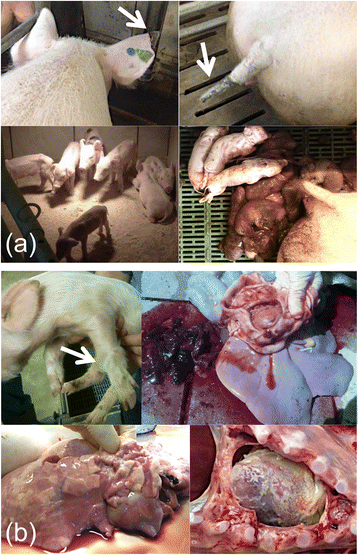

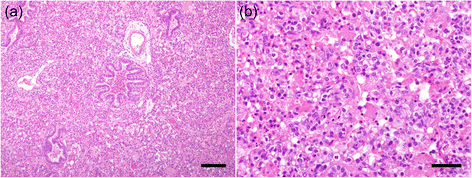
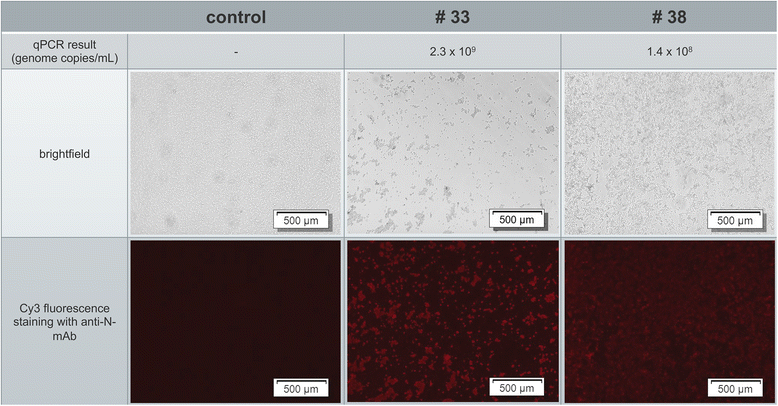
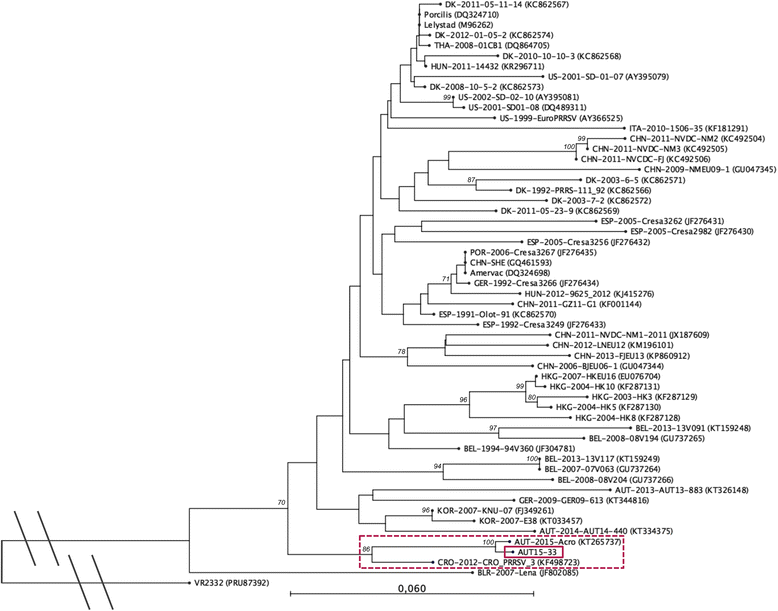
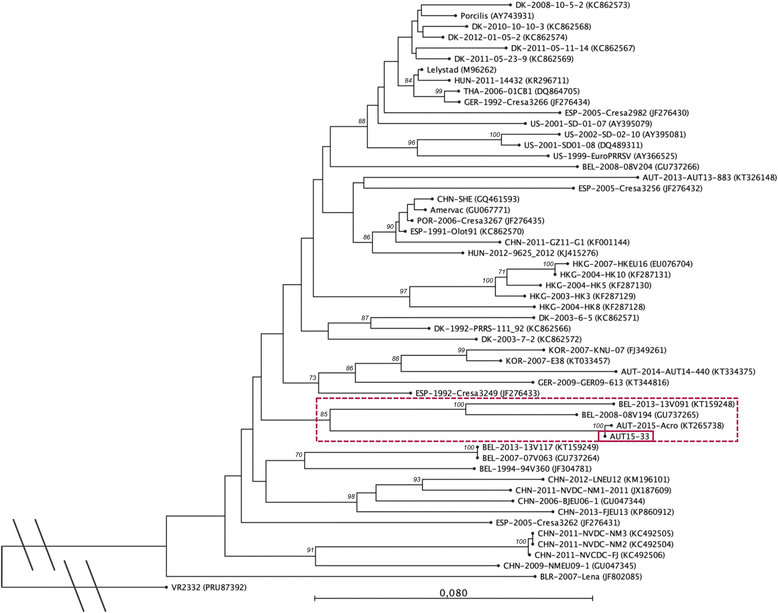
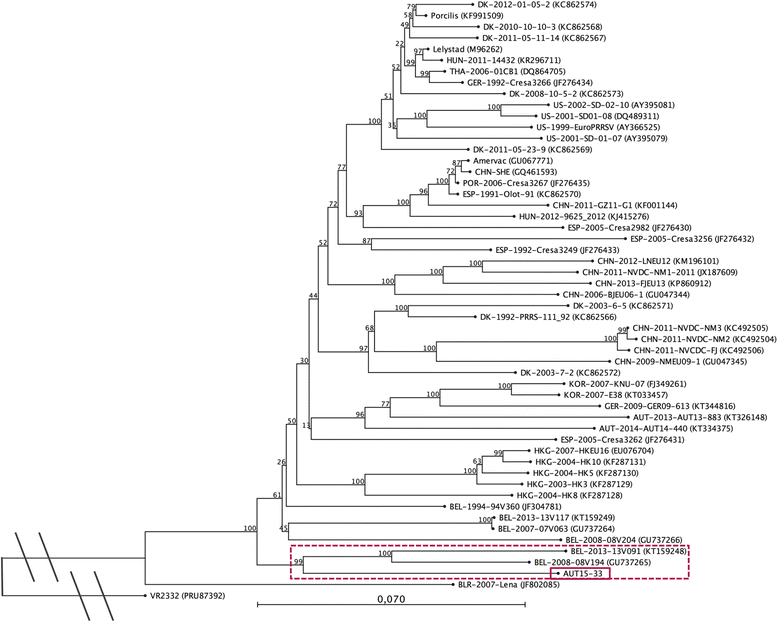
Similar articles
-
PRRSV-1 outbreak in a farrowing farm caused by a vaccine derived strain: a case report.Porcine Health Manag. 2025 Feb 17;11(1):9. doi: 10.1186/s40813-025-00425-w. Porcine Health Manag. 2025. PMID: 39962624 Free PMC article.
-
The molecular characteristic analysis of PRRSV GSWW/2015 strain and its pathogenicity to pigs.BMC Vet Res. 2018 Aug 17;14(1):240. doi: 10.1186/s12917-018-1548-3. BMC Vet Res. 2018. PMID: 30119669 Free PMC article.
-
Porcine reproductive and respiratory syndrome virus (PRRSV) from the first outbreak of India shows close relationship with the highly pathogenic variant of China.Vet Q. 2015;35(4):186-93. doi: 10.1080/01652176.2015.1066043. Epub 2015 Jul 16. Vet Q. 2015. PMID: 26107007
-
Research Progress on the detection methods of porcine reproductive and respiratory syndrome virus.Front Microbiol. 2023 Mar 9;14:1097905. doi: 10.3389/fmicb.2023.1097905. eCollection 2023. Front Microbiol. 2023. PMID: 36970703 Free PMC article. Review.
-
The scene of lung pathology during PRRSV-1 infection.Front Vet Sci. 2024 Mar 19;11:1330990. doi: 10.3389/fvets.2024.1330990. eCollection 2024. Front Vet Sci. 2024. PMID: 38566751 Free PMC article. Review.
Cited by
-
A Conserved Stem-Loop Structure within ORF5 Is a Frequent Recombination Hotspot for Porcine Reproductive and Respiratory Syndrome Virus 1 (PRRSV-1) with a Particular Modified Live Virus (MLV) Strain.Viruses. 2023 Jan 16;15(1):258. doi: 10.3390/v15010258. Viruses. 2023. PMID: 36680298 Free PMC article.
-
Efficacy of a Modified Live Virus Vaccine against Porcine Reproductive and Respiratory Syndrome Virus 1 (PRRSV-1) Administered to 1-Day-Old Piglets in Front of Heterologous PRRSV-1 Challenge.Pathogens. 2021 Oct 18;10(10):1342. doi: 10.3390/pathogens10101342. Pathogens. 2021. PMID: 34684293 Free PMC article.
-
Gene expression of peripheral blood mononuclear cells and CD8+ T cells from gilts after PRRSV infection.Front Immunol. 2023 Jun 20;14:1159970. doi: 10.3389/fimmu.2023.1159970. eCollection 2023. Front Immunol. 2023. PMID: 37409113 Free PMC article.
-
Experimental efficacy of vaccination of weaned piglets with a modified-live commercial PRRS virus vaccine against the challenge with a Spanish highly virulent PRRSV-1 strain.Porcine Health Manag. 2025 Feb 21;11(1):10. doi: 10.1186/s40813-025-00423-y. Porcine Health Manag. 2025. PMID: 39985097 Free PMC article.
-
Influence of PRRSV-1 vaccination and infection on mononuclear immune cells at the maternal-fetal interface.Front Immunol. 2022 Nov 8;13:1055048. doi: 10.3389/fimmu.2022.1055048. eCollection 2022. Front Immunol. 2022. PMID: 36426366 Free PMC article.
References
-
- Benfield DA, Nelson E, Collins JE, Harris L, Goyal SM, Robison D, Christianson WT, Morrison RB, Gorcyca D, Chladek D. Characterization of swine infertility and respiratory syndrome (SIRS) virus (isolate ATCC VR-2332) J Vet Diagn Invest. 1992;4:127–133. doi: 10.1177/104063879200400202. - DOI - PubMed
-
- Cavanagh D. Nidovirales: a new order comprising Coronaviridae and Arteriviridae. Arch Virol. 1997;142:629–633. - PubMed
-
- Snijder EJ, Kikkert M. Arteriviruses. In: Knipe DM, Howley PM, editors. Fields virology. Philadelphia: Lippincott Williams & Wilkins; 2013. pp. 859–879.
-
- Adams MJ, Lefkowitz EJ, King AM, Harrach B, Harrison RL, Knowles NJ, Kropinski AM, Krupovic M, Kuhn JH, Mushegian AR, et al. Ratification vote on taxonomic proposals to the International Committee on Taxonomy of Viruses (2016) Arch Virol. 2016;161:2921–2949. doi: 10.1007/s00705-016-2977-6. - DOI - PMC - PubMed
Publication types
LinkOut - more resources
Full Text Sources
Other Literature Sources

